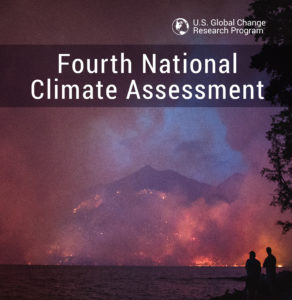It’s official: the country with the strongest economy and military in the world has recognized that climate change does exist, and that it is having an impact that can be felt in the here and now. Last week, the United States Global Change Research Program (USGCRP) released their 2018 Climate Report in accordance with a law passed by Congress in 1990. This law requires that a report measuring the effect climate change has on several different areas, from transportation and health, to agriculture and biological diversity, is due every 4 years, making this the 4th such report. Importantly, these reports make predictions of trends that can be expected to occur over the next 25 to 100 years.
 The report makes no qualms about the validity of climate science and the effect that greenhouse gas emissions have on the gradual warming of the planet. It is a fact. This position varies drastically from the discourse that was had just a few short years ago. There seemed to be three camps: those that believed in the science behind climate change, those that did not, and those that didn’t know one way or another. With the release of this report, the categories have been whittled down to two: those who believe in the science behind climate change, and those who are uneducated.
The report makes no qualms about the validity of climate science and the effect that greenhouse gas emissions have on the gradual warming of the planet. It is a fact. This position varies drastically from the discourse that was had just a few short years ago. There seemed to be three camps: those that believed in the science behind climate change, those that did not, and those that didn’t know one way or another. With the release of this report, the categories have been whittled down to two: those who believe in the science behind climate change, and those who are uneducated.
It seems that the tide has turned with the rising ocean levels. The report dedicates considerable real estate to the bevy of natural disasters that seemed to have piled up, one on top of another, over the past couple years. Last year, the United States witnessed not one, but two of the most costly hurricanes in recorded history occurring within a couple weeks of each other; Harvey and Maria, ranking second and third on the list of most destructive hurricanes, cost Americans an estimated $215 billion dollars in collateral damages. Add to this the extended droughts that primed the woodlands for wildfires, which claimed 10.1 million acres in 2015. The report notes that the California wildfires, in October 2017 alone, destroyed 2,500 structures and caused over $1 billion in damages.
The report seems to be one long bad news parade, spelling out disaster in almost every arena. In the future, society will be plagued by disease and pestilence, and very likely will be submerged under 10 feet of water. Or, at least, that’ll be akin to the fate of the trillion-dollar coastal property market in the United States, which has already sustained irreversible damage. Therein lies the strategy of the drafters of the report. There is no shortage of heartbreaking factotums in the 1,656 pages, such as the prediction that the poor, minorities, Native Americans, and other underserved and maligned populations will be the hardest hit. But, the crux of the argument centers around brass tacks.
There is no mistaking to whom this report is addressed. From the very first, it positions itself on a number of current events. Most notably, it dances on the grave of coal-generated electricity in the United States by celebrating the now cheaper (and cleaner) alternative offered by natural gas. How could those involved with putting out this report not be aware that a certain realtor/celebrity turned Leader of the Free World had aspirations of championing coal before it became a lost cause? Apart from coal, the current Commander in Chief of the United States has taken other steps to undermine the concerns of environmentalists, including his plan to walk away from the Paris Agreement and his staunch determination to undo regulations designed to curb greenhouse gas emissions.
So with this in mind, the report makes a good-faith effort to talk in terms familiar with the reader it would most like to sway. During the 2016 campaign, Trump trumpeted his credentials as a businessman- a claim which has recently been put under intense scrutiny. Still, the report makes a persuasive argument by talking dollars and cents: if nothing is done, if the United States stays upon the course it currently travels, it’ll get too hot to work. By 2090, experts agree that a 15 degree Fahrenheit raise in average temperatures will lead to approximately a loss of 2 billion labor hours annually, which amounts to around $160 billion in lost wages. The president doesn’t believe it. His issue isn’t with the science or the statistics, but with the bill. Perhaps he is looking to make a deal and is thus waiting for a counteroffer.



